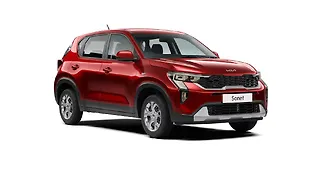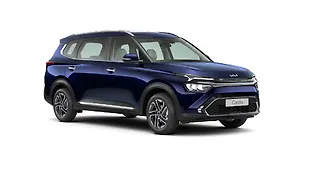Introduction

When looking to buy a sub-four metre SUV, you’d be advised to look at the high-sellers or the popular models in the segment. Scrolling through the brochures of Maruti Suzuki Vitara Brezza or the Hyundai Venue (which are current bestsellers), you might realise this segment has a few more deserving yet understated contenders. Apart from the five-star NCAP certified, Indian-bred Mahindra XUV300 and Tata Nexon, you also have a relative newcomer in the form of the Kia Sonet. Despite being a soul-sister of the Venue, the Sonet does make a strong case for itself amongst the well-established contenders. Since this is a fairly crowded segment, we have compared other players as well and you can read about them over here.
Here we take a look at these three capable candidates and tell you which one you could consider putting your money on if you are looking to buy a sub-four metre SUV.
Performance

All three models here are offering both petrol and diesel engine options which is a rarity since the BS6 norms kicked in. Of the three, the Sonet has the most versatile engine lineup with two petrol (including a 1.0-litre turbo-petrol) engines, a strong diesel, and no less than four transmission choices. Meanwhile, the understated XUV300 now has an AMT on offer for both the petrol and diesel derivatives.

Since it’s a diesel ensemble here, let’s take a look at the performance of these three in their oil-burner guise. Starting with the Nexon, the oldest model here gets a 1.5-litre four-cylinder, putting out 108bhp and 260Nm and can be had either with a six-speed manual or an AMT. Meanwhile, the XUV300 gets a 1.5-litre four-cylinder diesel which makes slightly more 115bhp and 300Nm. Similar to the Nexon, the XUV300 is available with a six-speed manual and an AMT. Lastly, the Sonet debuts with a 1.5-litre diesel that’s down on power amongst its rivals here with an output of 99bhp and 240Nm. But that’s the case with the manual transmission. Go for the torque-converter – the only one in its class with this combo – and the output raises to 113bhp and 250Nm.

In terms of performance, despite being a tad down on output numbers, the Nexon impresses with the quickest acceleration times, albeit by a tiny margin. But when it comes to roll-on acceleration, it’s where the Mahindra truly shines. A strong mid-range in the XUV300’s turbo-diesel results in it being quicker by almost three seconds when accelerating from 40-100kmph in fourth gear. The XUV300 is also quicker by a considerable margin when doing the run of 20-80kmph in the third gear compared to the other two.
| Performance (seconds) | Tata Nexon | Kia Sonet | Mahindra XUV300 |
| 0-60kmph | 5.34 | 5.69 | 5.36 |
| 0-100kmph | 12.73 | 12.75 | 12.88 |
| 20-80kmph in third gear | 9.89 | 10.19 | 9.16 |
| 40-100kmph in fourth gear | 13.92 | 13.90 | 10.54 |
Fuel Efficiency
Where the Sonet is down on power figures, it makes up for it by offering the best fuel mileage of the trio. It’s helped by the fact that it’s also the lightest of the three – by almost 90kg compared to the Nexon and a whopping 220kg than the XUV300.

This results in impressive fuel efficiency of 16.28kmpl in the city and 21.90kmpl on the highway. Interestingly, the Nexon is marginally better in city fuel efficiency compared to the XUV300, but the latter with its well-spread power band proves frugal out on the highway.
| Fuel economy | Tata Nexon | Kia Sonet | Mahindra XUV300 |
| Weight | 1,300kg | 1,210kg | 1,430kg |
| City | 13.9kmpl | 16.28kmpl | 13.76kmpl |
| Highway | 18.7kmpl | 21.90kmpl | 19.11kmpl |
Interior Space
Front Row Space
| Interior measurements | Tata Nexon | Kia Sonet | Mahindra XUV300 |
| Front Row Space | |||
| Legroom (max/min) | 820/630mm | 820/620mm | 850/620mm |
| Headroom (max/min) | 980mm | 950/880mm | 980mm |
| Shoulder room | 1,310mm | 1,290mm | 1,300mm |
| Backrest height | 590mm | 600mm | 650mm |

In terms of the cabin feel, the Kia Sonet appears to be the more modern of the two Indians. However, the Nexon and XUV300 offer more space, especially in terms of shoulder room. While the Nexon received an update last year, the XUV300 is yet to undergo its first major update since its introduction.

Yet the Mahindra doesn’t feel outdated or tacky by any means. The cascading centre console, high-quality plastic used at all the touchpoints, and leather upholstery make it feel more upmarket compared to its adversaries here. Meanwhile, Nexon offers glossy plastics, comfortable seats, a floating touchscreen, and a de facto spacious cabin. In comparison, the Sonet fights back by offering a few more features that are yet to be offered by the competition, which we’ll see in more details in the latter part.
Second Row Space
| Interior Measurement | Tata Nexon | Kia Sonet | Mahindra XUV300 |
| Second Row Space | |||
| Legroom (max/min) | 910/720mm | 820/620mm | 890/620mm |
| Ideal legroom | 730mm | 660mm | 740mm |
| Headroom | 920mm | 960mm | 920mm |
| Shoulder room | 1,380mm | 1,220mm | 1,220mm |
| Seat base length | 490mm | 480mm | 490mm |
| Backrest height | 610mm | 640mm | 590mm |

Similar to the front row, the second-row space in the Nexon and XUV300 is significantly more than what you get in the Sonet. The Nexon, with its wider rear-body shell, even offers the best-in-segment shoulder room of 1,380mm. Meanwhile, since the XUV300 is based on bigger Tivoli, it has a longer wheelbase helping it liberate more legroom for both rows.

Also, it needs to be pointed out that the seats in the Nexon are large and comfortable with ample support in all the right places, but they are on a softer side which raises the question of how they will fare in the long run. And the white upholstery in the XUV300 will take extra effort to maintain over time. In the Kia, while the scooped roof helps with ample headroom, legroom is just about adequate and it could do with more under-thigh support as well.
Boot
| Boot Space | Tata Nexon | Kia Sonet | Mahindra XUV300 |
| Boot | 368litres | 392litres | 257litres |
| Length/width/height | 710/940/550mm | 690/1080/580mm | 590/1050/610mm |
| Loading lip height | 680mm | 720mm | 840mm |

The only chink in the XUV300’s otherwise unblemished armour is its available boot space. With 257litres on offer, it is the smallest boot in the segment. On the other hand, Kia has managed to offer one of the highest boot spaces. With 392litres at disposal, it is also fairly square and usable with no obstruction and a low loading lip. On the flip side, it doesn’t have a split-seat fold which is a bummer. The Nexon’s 368litres boot space is also right on the money and has split-folding seats expanding its luggage carrying capacity furthermore.
Features

With its old-school approach, the XUV300 has proper analogue dials in the driver’s display where the updated Nexon and the new Sonet have started offering digital MIDs. Even the touchscreen unit on the Sonet is more comprehensive and has a fluidic touch and intuitive display. In comparison, Nexon’s infotainment screen needed an overhaul with the facelift, but that’s given a miss. And the multitude of buttons on the centre console of the XUV300 might not be to everyone’s liking. The Mahindra appears to be in the need of a major update on the inside more than the outside.

Common features amongst the three include a sunroof, auto headlamps, steering mounted controls, auto AC, cruise control, and smartphone connectivity with Apple CarPlay and Android Auto apart from the new-age telematics with a dedicated mobile application. In terms of safety, the XUV300 has seven airbags, hill-hold function, four disc-brakes, TPMS, front parking sensors, and child-seat anchoring. The Nexon too offers most of these features but only with dual-front airbags.

Lastly, Sonet has many unique features like wireless charging, paddle shifters (in automatic trims), cooled seats, mood lighting, voice command to operate sunroof, integrated air purifier, and rear-door sunshade, to name a few.
Price
| Ex-showroom price in lakh | Tata Nexon | Kia Sonet | Mahindra XUV300 |
| Diesel MT | Rs 8.50 to Rs 12.36 | Rs 8.35 to Rs 12.55 | Rs 8.97 to Rs 12.42 |
| Diesel AT/AMT | Rs 10.09 to Rs 12.96 | Rs 10.88 to Rs 13.35 | Rs 10.95 to Rs 13.09 |

In terms of pricing, the XUV300 commands a slight premium compared to the Nexon and the Sonet. This, despite the fact that it’s not been updated since its introduction might put off some buyers. Especially since the new-gen XUV300 is near the horizon. But the XUV300 is still a good-looking compact SUV with features and space in its stride along with solid built quality. It’s fun to drive as well. Meanwhile, Nexon makes a strong case for itself by offering a five-star NCAP safety rating along with a spacious cabin. It also scores high in terms of performance from its diesel motor and is a nice handler with a plush ride.

All three contenders here offer diesel as well as automatic, but the Sonet is the only one in the segment with a proper torque converter instead of an AMT. It’s also the most modern here, with conspicuous looks to go with an affluent feature list. It’s got a refined motor, a modern interior with first-in-class equipment, and a decently practical cabin with large boot space. As an overall package, the Sonet performs well and has an attractive price tag too to attract most buyers.

For first time buyers, the Nexon is a safe bet with its spacious cabin, good driving dynamics, and a high safety quotient. The XUV300 remains the underdog and we should see a tough fight instigated in the segment when the new-gen model arrives. And the Sonet is for those who want to flaunt their ride with the newest tech and styling.

![Kia Sonet [2020-2022] Image Kia Sonet [2020-2022] Image](https://imgd.aeplcdn.com/272x153/n/cw/ec/41523/sonet-exterior-right-front-three-quarter-110.jpeg?q=80)

























